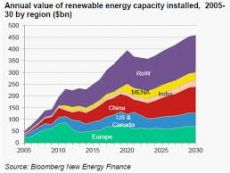
Email: emanuelealbertocirello.98@gmail.com
Total Article : 76
About Me:I am a Year 13 student which aspires to be an architect. I am interested in anything I don't yet know, and I mostly write about art, politics , Italian culture and inspirational people, although I will try to write for as many categories possible, just to test myself and get to know more things.

The high reliance on coal-fired power plants has caused serious pollution issues. Coal combustion has led to an extortionate amount of harmful chemicals emitted, such as nitrogen oxide, carbon dioxide and sulphur dioxide. These pollutants have affected the living environment of many regions and neighbouring countries such as Korea. The lack of energy efficiency and development of renewable resources is causing China to be held back due to environmental issues.
Chinese increasing energy demand is going to have significant impacts; by 2025 China’s CO2 emissions are going to amount 18% of the worlds’ total emissions.
The exploitation of fossils has caused issues in urban areas too. The air pollutants have caused the formation of acid rain, which actually falls n 30% of the country’s land.
Mercury released into the air by coal-fired power plants is captured by raindrops, and transferred to the soil, surface water and groundwater. Surface water affects the fish consumed. Groundwater is polluted by runoff from factories, smelters and mining operations, and then used by farmers downstream to irrigate their crops. Heavy use of fertilizers has contributed to contamination also.
China’s energy development is going to enter a new stage. With the adjustment and development of the country’s economic structure, energy policy will shift from the ensuring of fuel supplies to optimizations and environmental improvements.
One of the future plans is to control energy consumption and to especially limit coal consumption. In 2014 China’s coal consumption fell for the first time since the Asian economic crisis of 1998, and its decline continued in 2015. This is due to a slowdown in the industrial energy consumption and an increase in hydropower consumption. China’s coal chemical industry is still subject to environmental limitations, and the government aims to keep consumption below 4.8 billion tce by 2020, causing a drop in coal usage of 62%.
The future also sees the development of cleaner technologies for the country’s fossil fuel resources. The development of clean energy will be one of the country’s focus. The government aims to raise the consumption of natural gas by 10% in 2020. However this will be difficult to achieve due to the higher price of natural gas over cheap coal.
China has also focused attention on the development of nuclear power plants to reduce fossil fuel consumption. China aims to amount to 15% of non fossil fuel consumption by 2020. Currently nuclear power plants are under construction in the south eastern regions.
Wind power is also one of the key elements for China’s energy in the future. Up to 2015, the total installed wind power was 120 GW, leading the world in terms of wind energy. Its price is however 40% higher than coal and depending on the economic stability of some regions, wind power could be an alternative. Solar stations have also been greatly implemented, and is it supposed to reach a capacity of 100GW by 2020.
Some researchers however believe that despite the technological and structural developments, the future of China’s energy will also be affected by what they believe will be a decreasing population. Some think that China’s economic growth will gradually slow down and be more stable, from the current 7% to 5%-3% in 2030. Many also expect the population to reach a peak of 1.5 billion by 2030, and the aging trend will then start to show. This means that in the future, the energy demand of the country as a whole may significantly reduce.
China’s energy consumption average growth rate is meant to be less than 2% before 2030. This is a significant change considering that during 2000 to 2014 it was more than 8%. The total energy consumption in 2050 is also expected to be 10% lower than 2030.
Image credits: https://futurechallenges.org/local/renewables-in-europe-getting-past-the-crunch/

0 Comment:
Be the first one to comment on this article.